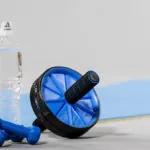There’s something primal about sprinting. No machines, no weights, no gadgets. Just you, your legs, and the clock.
HIIT sprint workouts might look easy on paper but the first time you try one, reality kicks in fast. You’re gasping by round two, your legs feel like bricks, and suddenly that 15-second sprint feels like a lifetime.
Still, if you’re looking for a fast, no-nonsense way to get leaner, build cardio, and boost athleticism, the HIIT sprint workout for beginners can deliver.
What Is a HIIT Sprint Workout?
HIIT sprint workouts are the purest form of HIIT. You’re not juggling six exercises or bouncing between circuits. It’s one thing, done right, and it wrecks you in the best way.
Even five rounds can leave you gasping for air and wondering what just happened. But that’s the point. Sprinting taps into your highest gear, boosts the afterburn effect, and drives real improvements in calorie burn, fat loss, and cardio endurance.
Why Sprints Work (Especially for Beginners)
Sprints on their own are one of the most powerful exercises you can do. They hit your entire body, fire up your metabolism, and build real athleticism. You’re training power, speed, coordination, and grit all in one shot.
Here’s what consistent sprinting could give you:
- Faster fat loss without needing long cardio sessions
- Improved heart health and VO2 max
- Better insulin sensitivity and blood sugar control
- Increased leg strength and explosive power
- Stronger joints and connective tissue (if you’re warmed up)
- Mental toughness from pushing through the burn
But the most important thing here is consistency. You won’t get these benefits from one sweaty session every two weeks.
Start with two or three sprint workouts per week. That’s the sweet spot for beginners.
If you’re doing other forms of training (lifting, sports, etc.), that might be plenty. If sprints are your main form of cardio, you can build up to four or five sessions per week. Just make sure your body keeps up.
How to Warm Up for HIIT Sprints
Here’s a simple warm-up routine before you do HIIT sprints:
- Light Jog or Fast Walk (2-3 minutes)
Gets your blood moving and wakes up your legs.
- Dynamic Leg Swings (10 per leg)
Forward/backward and side-to-side to open up your hips.
- High Knees (20 seconds)
Start waking up your stride.
- Butt Kicks (20 seconds)
Loosens up your quads and gets your hamstrings firing.
- Walking Lunges (10 per leg)
Adds control and range through your hips and knees.
- Strides (2 to 3 runs at 50-70% effort)
Ease into sprint mechanics without going full throttle.
Biggest Mistake With HIIT Sprint Workouts for Beginners
The biggest mistake beginners make with sprint workouts? Skipping the warm-up.
Sprints hit hard. Your legs, knees, and ankles take a beating if you go in cold. Even seasoned lifters and runners can get hurt if they skip prep. Spend 5-10 minutes warming up. It’s not optional.
The second biggest mistake? Not going hard enough.
HIIT means intensity. Your sprints should be close to max effort. If you’re cruising through, you’re just doing interval jogging. It’s supposed to burn. It’s supposed to be tough. Even if you only do five rounds, make them count. That’s how you get results.
Sample HIIT Sprint Workout for Beginners
Here’s a structure of a HIIT sprint workout for beginners:
Round Format:
- Sprint for 20-30 seconds (go hard)
- Walk or rest for 60-90 seconds
- Repeat for 4 to 6 rounds
Cool Down:
- Light walk for 3-5 minutes
- Stretch your quads, hamstrings, and calves
This is just a framework, not a rulebook. Try it and see how your body responds. If you’re gassed after four rounds, stop there. If you’ve still got something left in the tank, maybe add a round.
You can also adjust sprint time or rest time based on your fitness level. The goal is to push yourself, feel challenged, and finish tired but in control.
Final Thoughts – Can You Lose Weight With HIIT Sprint Workouts Alone?
Yes, HIIT sprint workouts can definitely help you lose weight. Especially if you’re a beginner who hasn’t been active lately, even a few short, intense sessions each week can kickstart fat loss and improve your fitness fast.
But no workout will outpace a bad week of habits.
You can sprint hard two or three times a week, whether that’s for 15 minutes or an hour. It all helps. But what you do the rest of the week matters even more. If your goal is weight loss, your daily calorie intake needs to be in check.
The key is a caloric deficit. Which means that you should be eating slightly less than what your body burns. A deficit of around 300 to 500 calories a day is enough to start seeing progress without feeling drained.
HIIT sprints make that easier by boosting your metabolism and burning more calories in less time. They don’t replace a good diet, but they absolutely speed things up when paired with it.
FAQ
Can I do HIIT sprints on a treadmill?
Yes, but it’s trickier. Treadmills take time to speed up and slow down, so they don’t match outdoor sprinting. If you use one, keep the belt running and carefully jump on/off during sprints.
Do I need to sprint at 100% effort?
Close to it, yes. Aim for around 85-95% of your max speed. You should feel like you’re pushing your limit, not jogging or cruising.
What if I can’t sprint?
Try power walking uphill, fast cycling intervals, or shuttle runs. The key is max effort for short bursts, no matter the movement.





